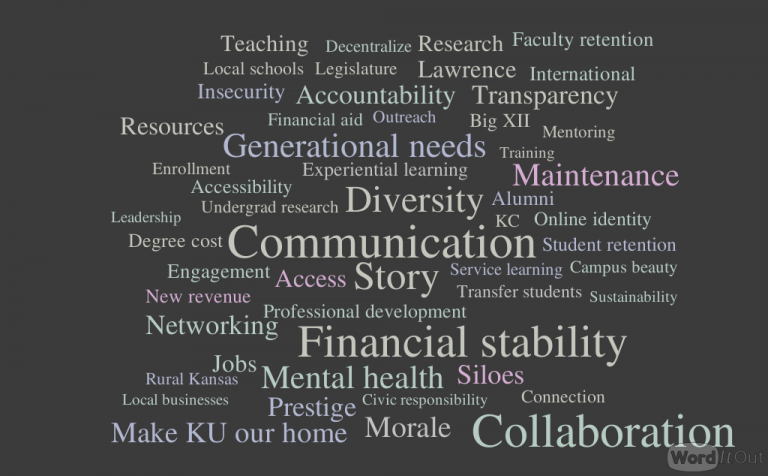Distilling hundreds of comments about the future of the university into something manageable and meaningful is, in understated terms, a challenge.
The university’s department of Analytics and Institutional Research accomplished that, though, creating a 73-item list that summarizes ideas from a fall planning session and from comments submitted through an online portal. That list, titled What We Could Do at KU, was distributed to the 150 or so university employees who gathered last week for a second strategic planning session. Presumably, Provost Barbara Bichelmeyer and Chancellor Doug Girod drew on those in creating another document that listed vision, mission and values statements, along with their institutional priorities. The priorities they laid out – student success, healthy and vibrant communities, and research and scholarship – offer a good sense of where they want the university to go in the coming years.

I have a few thoughts about those priorities – namely a lack of any mention of teaching – but I want to focus on something else first.
I found many connections among the 73 suggestions on the What We Could Do list, and I wanted a way to get a better grasp on those ideas. That’s because they provide a broad look at what employees around the university see as important.
I started by creating a spreadsheet, combining and paring the 73 suggestions into 68 words and short phrases. Think of it as a summary of a summary, which has both benefits and drawbacks. I then used those to create the two word clouds that accompany this article.
I wasn’t able to get all 68 words and phrases into a single word cloud, so I eliminated those that were mentioned by fewer than five people. I also created a separate list of 11 verbs that were used in the summary statements. Most describe a need to do more or less of something. This by no means indicates a consensus of ideas from around campus. Rather, it represents the opinions of those who were willing to take the time to attend a planning session or to submit comments online. (I was one of those people.)
Collaborate and communicate
There’s nothing startling on the list, but I was nonetheless surprised by the prominence of collaboration and communication. I agree with those wholeheartedly, and I’m glad others put them at the top of the list.
In far too many cases, departments and offices work in isolation (or in siloes, another word on the list) and even compete against one another for students, resources and attention. To improve as a university, we must find more ways to work together and see ourselves as part of a singular effort rather than as a collection of competing entities. We need to find more ways for our students to collaborate with faculty and with one another. We also need to collaborate with other colleges and universities, and with communities in Lawrence, Kansas City and across Kansas.

Doing that requires better communication internally and externally. We have to make sure potential partners around the university know what we are doing, and we need to tell our story (another prominent term) to students, families, businesses and communities. They need to understand that we are part of – not separate from – them.
Another frequently mentioned issue, financial stability, ties into other needs like maintenance, retention, accessibility, professional development, degree cost, campus beauty, mental health, morale, accountability and transparency.
Three other prominent terms on the list – diversity, mental health and generational needs – tie closely together. The diversity of the student body has increased over the last decade, but the student population at KU is still predominantly white. The faculty and staff are even less diverse. The current generations of students are more diverse and have different needs from previous generations.
Not surprisingly, most of the comments from around campus called for an increase in something, including diversity, revenue, accountability, prestige, student and faculty retention, and, of course, collaboration and communication. After years of underfunding and a few rounds of budget cuts, there are many unmet needs.
What about teaching?
If the What We Could Do at KU list represented the opinions of faculty and staff, a document called Jawhawks Rising gave a clear sense of where university leaders want to go. It’s a good aspirational document.
Strangely missing, though, is any mention of teaching. The document uses phrasing like “community of learners,” and “student engagement” and “educate leaders.” It lists “student success” as one of three core institutional priorities.
Teaching doesn’t show up anywhere, though. That’s discouraging and disturbing. You can argue that “educate” involves teaching. It does. But without a clear strategy for improving and elevating the importance of teaching, any attempt to improve student success will fall short. And without the involvement of faculty in student success, the vision, the mission and the values of the institution quickly become hollow.
All of this is a work in progress, and encouragingly, Bichelmeyer gave teaching an important nod in remarks she made at the start of the strategic planning session last week.
“We’re learning about how we teach and how our students learn,” Bichelmeyer said, referring to the use of analytics to examine curricula and student movement through curricula. “There are lots of ways where we can start to unpack the individual student from the crowd through watching and knowing that they need a nudge to say, ‘It’s really important for you to get to the first week of class’ or ‘It’s really important that you don’t turn your homework in late.’ ”
She added: “We’re not teaching little widgets on an assembly line where we hold time constant and let achievement vary or we think about our work as production.”
She also pointed to the need to change our approach to engaging students, many of whom work 20 or more hours a week and have family responsibilities. They also see technology as an important part of who they are.
“Students would rather have a lecture on YouTube than sit in a class with a thousand students where they can’t see the professor and they can’t see what’s on the board and they maybe can’t hear,” Bichelmeyer said. “And they don’t have to pay for parking, and they don’t have to get a babysitter, and they can do that at night.
“So when we think about unbundling the elements of instruction, we have to understand that what we do well at the University of Kansas that nobody else can do is we engage students,” she added.
Unbundling and rethinking
Additionally, she said, digital technology is leading to the separation of teaching from certification. That is, students no longer need a university credential to get good jobs. They can learn from many online providers or gain skills from short-term coding camps and other intensive sessions that don’t require a four- or five-year commitment and cost far less than a university degree.
“So we have to think about what it is that only we can do really well and how we think about the educational experience from the students’ perspective in order to help them think about why it’s worth it for them to be at KU,” Bichelmeyer said.
Think collaboration, communication, diversity, generational needs, networking, accessibility, engagement, cost and other terms from the campus list. But also think teaching and learning, which is why students come to the university in the first place.
ed to collaborate with other colleges and universities, and with communities in Lawrence, Kansas City and across Kansas.